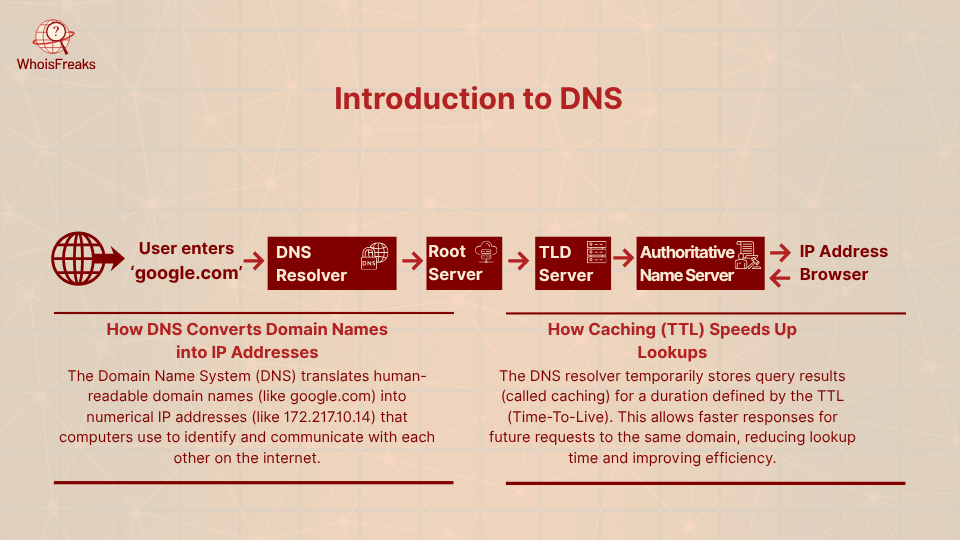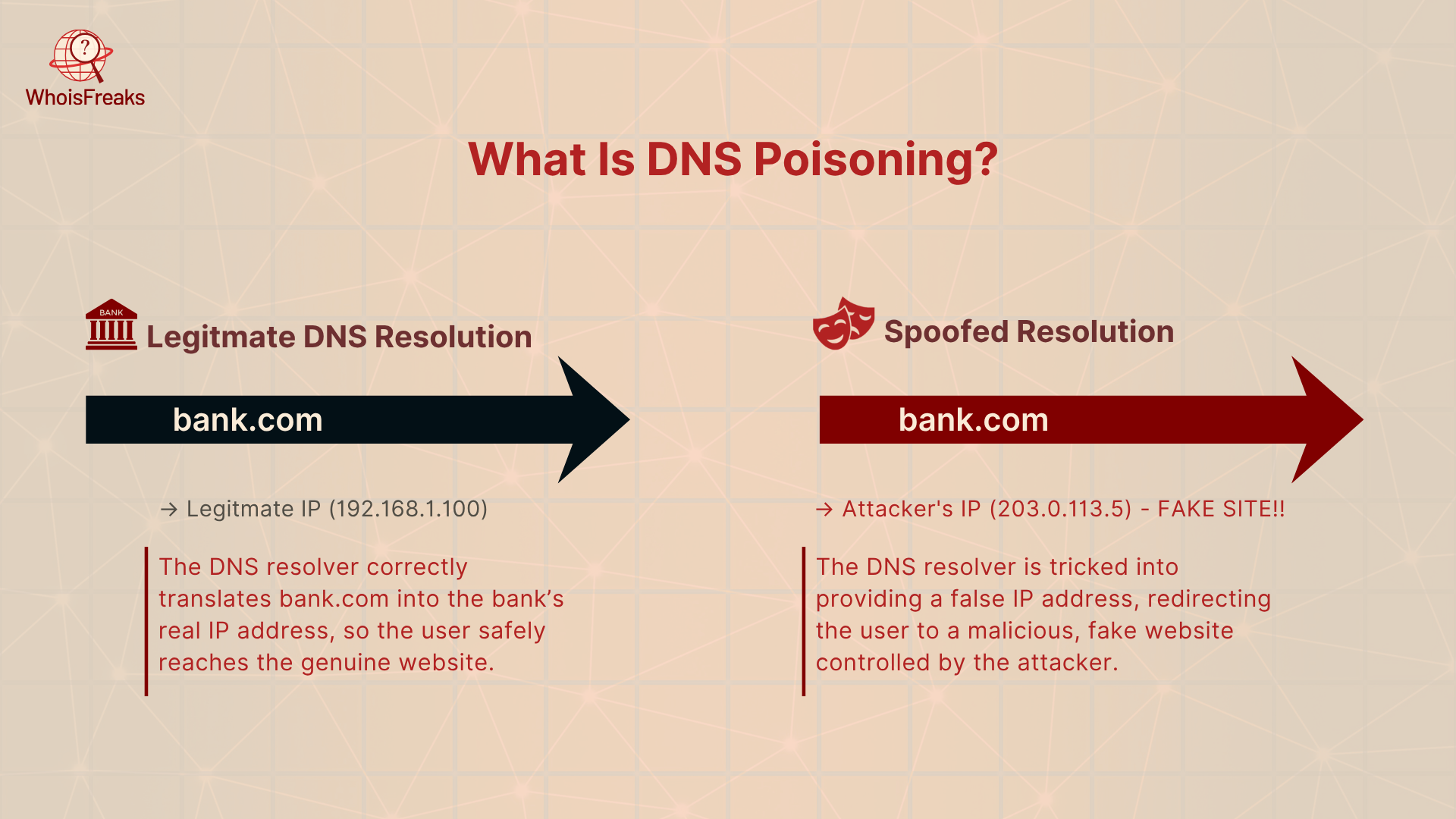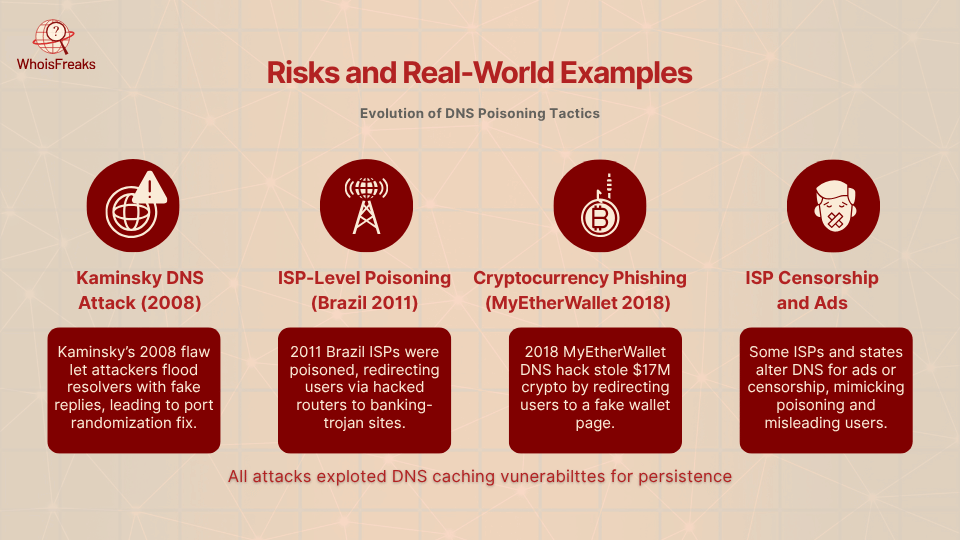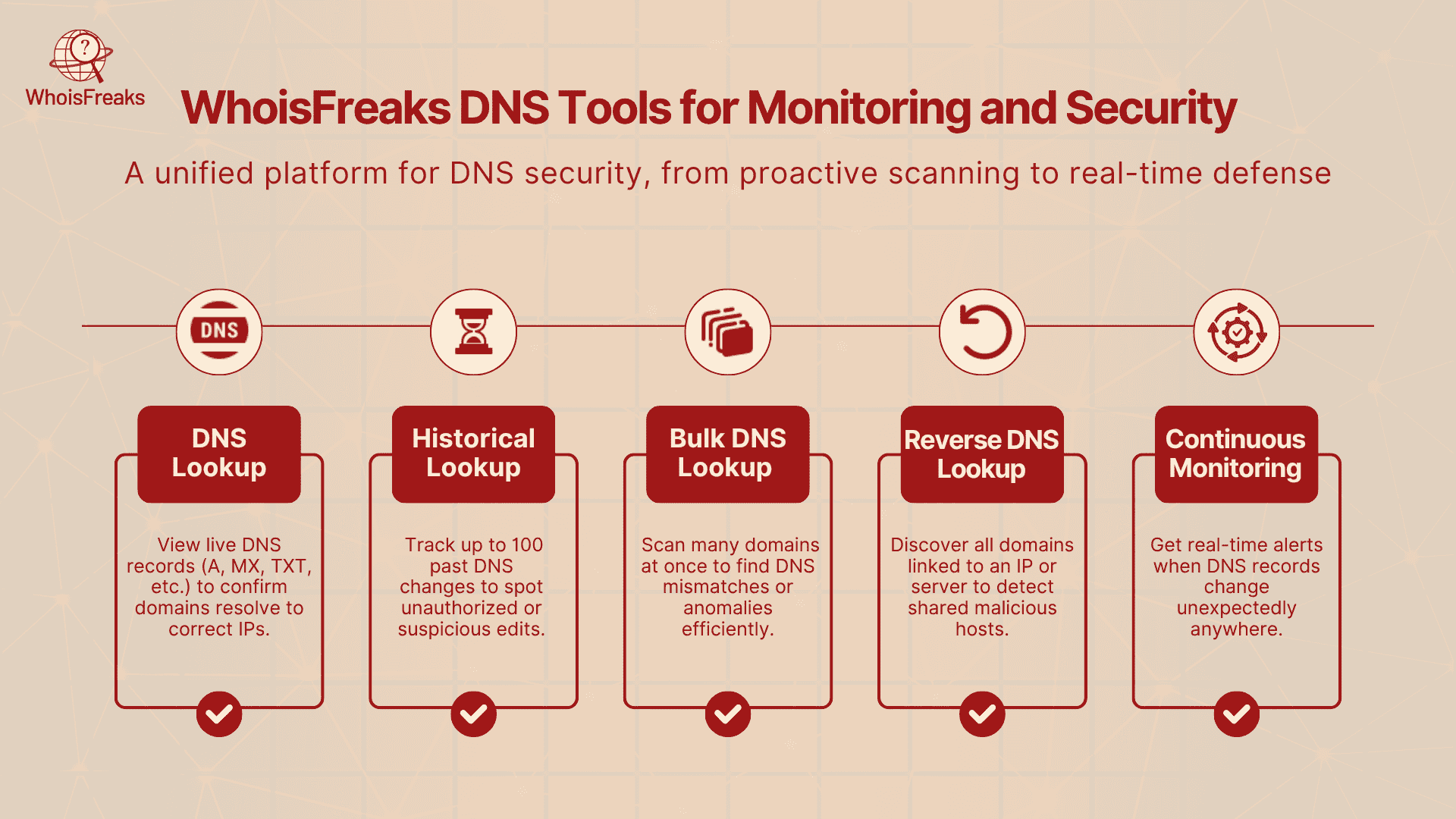Understanding DNS Poisoning: Risks and Prevention Strategies
The Domain Name System (DNS) is the internet phonebook critical to the DNS infrastructure. It converts human-understandable domain names (such as that of google.com) into numerical IP addresses, which is used by computers. When you enter a name of a website, your computer requests a DNS resolver to provide the IP address of the same. The resolver caches answers in a time limit (the TTL) so as to make lookups faster. This is like a local address book: once an entry is saved, it can be reused until it expires, making browsing faster.

If the resolver doesn’t have the answer cached, it will query DNS root servers and follow the chain of authority (top-level domain servers, then the domain’s own name servers) to find the IP. Each step’s result can then be cached for subsequent queries. Caching makes DNS efficient, but it also means that if a wrong answer is inserted, it will stay in place until its TTL runs out. Normally there is no built-in verification of cache data, so a bogus response can go unnoticed until it is either overwritten or expired
What Is DNS Poisoning?

DNS poisoning (also called DNS spoofing or cache poisoning) is an attack that includes DNS spoofing attacks which corrupt the information in a DNS cache so that queries return the wrong IP address. In other words, attackers inject false DNS records into a resolver’s cache. Cloudflare describes this as “entering false information into a DNS cache” so that users are directed to the wrong websites. In effect, DNS poisoning tricks the system into treating a malicious IP as the legitimate address for a real domain.
For example, you might think you’re visiting your bank’s website, but end up on a fake site designed to steal your login details. In this scenario the attacker has forced the DNS resolver to cache an incorrect A record (the bank’s site IP). From then on, anyone querying the bank’s domain is sent to the attacker’s server instead of the real bank’s. In effect, people innocently following the usual URL are secretly connected to the attacker’s server.
DNS poisoning is particularly dangerous since it is many times undetected. The browsers can still display the right URL and the page can appear normal with some minor differences, which may conceal spoofing attacks . The fraud may be identified only through close inspection or through warnings of the browsers (SSL certificate is not valid). When a victim realizes that something is amiss, the attacker can have stolen credentials or even planted malware.
How Attacks Work?

There are different ways through which attackers poison DNS caches. One of the widely used methods is to overwhelm DNS server software by flooding a resolver with bogus DNS responses when it issues a query. The attacker remodels the response to appear as one that was sent by an authentic DNS server. DNS queries normally operate over the UDP protocol without a handshake, and therefore the resolver can accept the first matching answer that it gets. When the spoofed response has the incorrect IP and corresponds to the query transaction ID and source port, the resolver will store the bogus record.
The other technique is a man-in-the-middle attack. As an illustration, an attacker can spoof a DNS query on an open Wi-Fi hotspot and respond instantly with a spoofed response. Instead, the attackers can use the bugs or the compromised DNS servers to inject the bad records. Whichever way, when a fake entry has been logged in the DNS cache, it will stay there until the TTL has expired or the cache is cleared by hand. All customers accessing the resolver that is poisoned will be redirected to the rogue site at that time, allowing attackers to redirect traffic .
In practice, this can affect many users at once without any change to the domain’s official settings. Modern DNS servers randomize source ports and use large transaction IDs to make spoofing harder, but resolvers and network caches (including those on home routers or at ISPs) can still be targets if not properly protected.
Risks and Real-World Examples
The consequences of DNS poisoning are severe. Victims may be sent to fake websites that steal credentials or deliver malware. Traffic can be diverted for phishing, man-in-the-middle eavesdropping, or drive-by downloads. In short, a DNS poisoning attack enables credential theft, malware infections, and a loss of user trust. Even well-known brands can suffer if their customer traffic is hijacked.
These dangers have played out in many real incidents:

1. Kaminsky DNS Attack (2008)
Security vulnerability in the DNS presented by a security researcher called Dan Kaminsky resulted in a disastrous ease in poisoning. With a large scalability, an attacker could add spoofed replies to the cache by flooding a resolver with spoofed replies. The discovery by Kaminsky provoked the need to fix (such as randomization of ports) the problem urgently but demonstrated that core DNS assumptions were vulnerable.
2. ISP-Level Poisoning (Brazil 2011)
In late 2011, Kaspersky found massive DNS cache poisoning of Brazilian ISPs. Attackers hijacked DNS queries so users were sent to malicious sites. One campaign tricked users into downloading a banking Trojan disguised as a “Google Defense” tool. Alarmingly, attackers even hacked routers or modems to change their DNS settings. As a result, when employees tried to visit normal websites, the compromised routers redirected them to malware-laden pages.
3. Cryptocurrency Phishing (MyEtherWallet 2018)
DNS poisoning was used on the Ethereum wallet MyEtherWallet. The visitors visiting the site were automatically redirected into a fake page where their keys were stolen. The fraud went undetected and over 17$ million cryptocurrency was stolen. As it is demonstrated in this case, even the high-value services and tech-savvy users can fall victim to the attack provided that the DNS records are altered.
4. ISP Censorship and Ads
Some ISPs and governments have deliberately altered DNS records for censorship or advertising. While not criminal attacks in the traditional sense, these actions function exactly like poisoning. In each case, users end up on unintended sites. Such examples underline that any unexpected DNS change must be watched, even “legitimate” alterations can disrupt users.
In all these examples, legitimate domain names were mapped to malicious IP addresses without users realizing it. By the time any warning appears (like a certificate alert or an anomalous pop-up), the attackers may already have captured data or installed malware.
Prevention and Mitigation Strategies
Fortunately, many defenses can greatly reduce the risk of DNS poisoning:

- Enable DNSSEC: DNS Security Extensions (DNSSEC) are cryptographic signatures to DNS records. DNSSSEC validating resolvers will reject any forged replies since the signatures will not be identical. In practice, DNSSEC allows the clients to check that DNS information is actually issued by the authority. According to experts, the use of DNSSEC is among the most effective tools of defense against cache poisoning.
- Patch and update servers: Maintain all DNS software (both authoritative servers and resolvers) up to date. Patches often fix vulnerabilities that attackers could exploit to insert bogus records. Periodic upgrading removes the vulnerabilities that are known in DNS implementations.
- Randomize ports and IDs: Use unpredictable sources ports and transaction IDs by configuring your DNS resolvers. When a response is forged, it becomes significantly more difficult to determine the right values with the help of proper randomness.
- Use encrypted DNS (DoH/DoT): Encrypting DNS queries and responses (via DNS-over-HTTPS or DNS-over-TLS) prevents on-path attackers from seeing or modifying them. Even if the network is compromised the encrypted DNS channel makes the spoofing extremely hard.
- Control resolver access: Periodically check your DNS records with such a tool as dig or nslookup. Ask your domains in various points or places and compare the responses. A cache can be poisoned in case one of the resolvers happens to give an unexpected IP. It is more convenient to identify the unauthorized changes detected in a short time by keeping a manual record or script of the appropriate DNS configuration.
- Regular audits and checks: Periodically verify your DNS records using tools like dig or nslookup. Query your domains from multiple locations or devices and compare the answers. If one resolver returns an unexpected IP, that cache may be poisoned. Keeping a manual record or script of the correct DNS configuration makes it easier to spot unauthorized changes quickly.
- Educate users: Train staff and users to be able to identify DNS tampering signs. As an illustration, when a trusted site appears unfamiliar to a user or a browser has issued a security warning, user must verify the address and DNS. Educate them on how to empty local DNS cache on their computer or router in case there is suspicion of poisoning. Intelligent users are a valuable final barrier.
WhoisFreaks DNS Tools for Monitoring and Security
WhoisFreaks boasts over 12 billion DNS records across 1,500+ top-level domains (TLDs). WhoisFreaks offers domain and DNS intelligence tools to help detect or prevent DNS issues:

- DNS Lookup Tool: Fetch live DNS records (A, AAAA, MX, NS, SPF, TXT, CNAME, etc.) for any domain. Verify that a domain’s current DNS entries match your official configuration. Running lookups from different locations can reveal if a resolver is returning a malicious IP address.
- Historical DNS Lookup Tool: Retrieve up to 100 past DNS records for a domain. Analysis of this history will reveal the exact time and manner in which domain DNS entries changed with time. Monitoring such changes can assist in detecting unauthorized modifications since WhoisFreaks mentions that history search could reveal any unauthorized or suspicious modification in the DNS settings.
- Bulk DNS Lookup Tool: Check the DNS records of a bulk of domains at once. It is applicable in cases of organizations with numerous sites or subdomains. It is easy to detect anomalies by comparing results (e.g. one domain resolved to a different IP).
- Reverse DNS Lookup Tool: Determine all the domains that a particular IP address, name server or mail server is related to. This can tell whether or not any malicious domains share infrastructure with yours. For example, if a phishing site uses the same name server as your legitimate domain, a reverse lookup would flag that link.
- Continuous DNS Monitoring: WhoisFreaks continuously crawls DNS data across the internet, keeping an up-to-date DNS. Their system “swiftly [detects] and [records] changes as they occur,” so you can be alerted if an unexpected DNS update. Early alerts mean you can respond before any harm spreads.
Conclusion
DNS poisoning is one of those silent attacks that can cause serious damage before anyone even notices. To counter this threat, measures to prevent DNS poisoning are essential as it allows hackers to secretly redirect users to fake or harmful websites putting data, reputation, and trust at risk. Real-world incidents like the MyEtherWallet breach and large-scale ISP attacks show how dangerous this threat can be.
The positive side of the situation is that these attacks on domain name system security are preventable through the appropriate awareness and equipment. With DNSSEC, periodically verifying your DNS records, maintaining systems and tracking DNS activity are viable methods of ensuring that you have not been compromised.
To simplify this process, you can use such tools as DNS Lookup, Historical DNS Lookup, and DNS Monitoring by WhoisFreaks that will allow you to monitor any suspicious activity in the DNS records of your domain. Such tools provide visibility to you and early warnings in case anything goes amiss to take an action before it is too late.

Stay ahead of attackers and secure your domains today with WhoisFreaks' DNS monitoring tools.
Explore WhoisFreaks DNS Tools
FAQs
1. What are the signs of DNS poisoning?
If a website looks strange, loads the wrong page, or your browser warns about an invalid certificate, it could be a sign of DNS poisoning.
2. How do you flush out your DNS cache?
You can clear your DNS cache by using a simple command for example, type ipconfig /flushdns in Windows Command Prompt to remove old or fake DNS entries.
3. What does a DNS attack do?
A DNS attack tricks your system into visiting fake websites, allowing hackers to steal your information or spread malware.
3. What is DNS sinkhole and DNS poisoning?
DNS poisoning redirects users to fake or harmful sites, while a DNS sinkhole safely redirects bad traffic to a controlled server to block malicious domains and mitigate cache poisoning attacks.

Software Engineer
A software engineer focused on developing scalable, efficient solutions. Expertise in coding, system optimization, and utilizing advanced technologies for high-performance apps.
Related Posts

Defending Against DNS Flood Attacks: Leveraging Wh...
Learn how a DNS flooder can threaten your network security and discover practical measures to protect your systems. Read more to safeguard your networ...
Published at: Oct 27, 2025

What is the Purpose of DNS Server? Understanding I...
Discover the essential role of DNS servers in internet functionality and learn how they enhance your online experience. Read the article for insights.
Published at: Oct 24, 2025

5 DNS Misconfigurations That Could Be Damaging You...
Discover 5 common DNS misconfigurations that can harm your email reputation. Ensure your emails land in inboxes, not spam. Read the article for soluti...
Published at: Jun 3, 2025